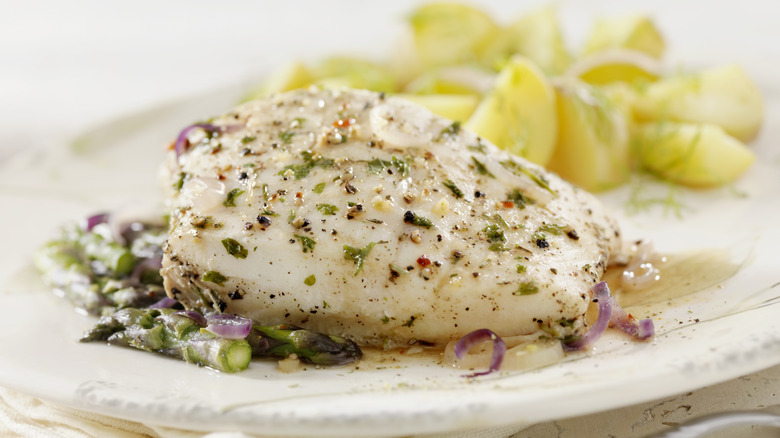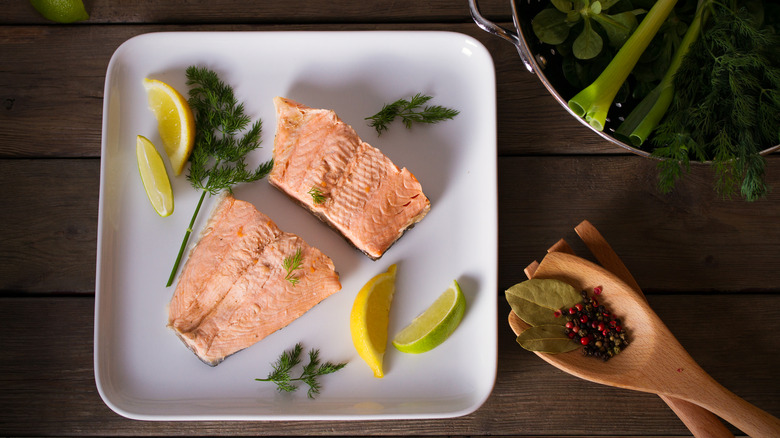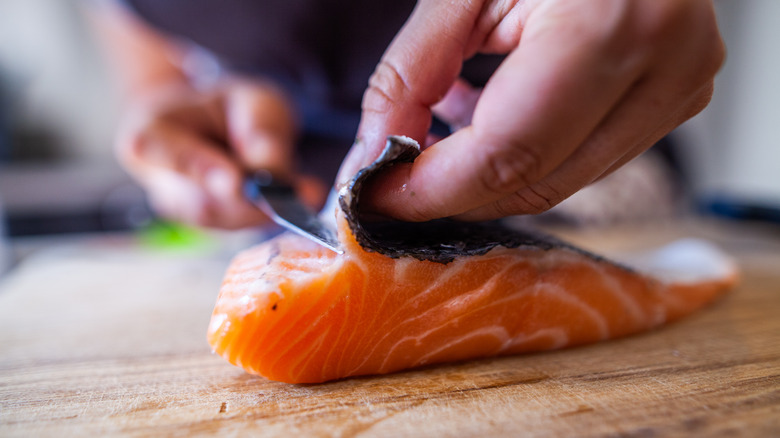Why Poaching Fish Is Perfect For Anyone Picky About Seafood
There are many who are hesitant when it comes to trying seafood. Its strong, fishy smell and slimy, chewy texture can be off-putting, and when it comes to cooking, fish can be incredibly fickle. Seafood is easy to overcook, resulting in a rubbery, dry meal, which is far from a pleasant eating experience. For those who love to cook seafood, this can prove a difficult challenge to address if family and friends shy away from eating it. When looking for a way to get picky eaters to try fish, consider poaching as a solution.
If this cooking method isn't on your radar already, it should be. It isn't just for poached eggs, after all. Poaching helps keep your fish delicate, preventing it from becoming a chewy mess that will turn off many from eating seafood. This cooking method helps a dish retain moisture, so the fish stays tender and delicious. Additionally, the longer seafood is cooked, the more the fishy flavor is muted. That means that poaching, which takes time, ensures those who dislike fish's fishy taste and rubbery flavor will reconsider their opinions on seafood.
How to poach seafood
Poaching fish is nothing new. It's a classic technique that involves submerging the food in fluid. Unlike with boiling or simmering, the poaching liquid is kept at a low temperature, typically between 140 and 190 degrees Fahrenheit. This makes it great for lean proteins like seafood, which often dry out when cooked. Because the temperature is so low, it's virtually impossible to overcook fish with poaching, making this a great method for those who might be less experienced in the kitchen. However, there are a few different techniques you could use here, including submersion poaching and shallow poaching.
Most often, you'll want to use the common submersion method, which means you'll need to fully cover the fish with poaching fluid. This is true for most poaching liquids, but for some, like oil, shallow poaching works well. Shallow poaching only partially covers the fish in liquid. One of the advantages of this method is that the liquid reduces to a sauce during cooking, which can be added back to the dish. While cooking time varies based on the liquid used, it typically takes 10 minutes per each inch of the fish's thickness. Though poaching seafood involves more than just cooking it in fluid at low temperature, there's a lot to consider, including poaching liquid and techniques.
Tips for poaching fish
Before poaching your fish, it's best to remove the skin, as poaching can make it slimy and unpleasant. Additionally, make a few small slits on the skin side to prevent the fat from warping. This skin-scoring method is great for poaching fattier fish like salmon and trout. Once you're ready to heat the liquid, it's best to use a thermometer to keep the poaching fluid at the right temperature. A simple extra step that'll keep your fish extra moist is to add a cooler fluid to the poaching liquid to reduce the temperature and results in smoother cooking.
The key component when it comes to poaching is the fluid. Consider aromatic court bouillon for a simple but effective option, as a lot of the resulting taste comes from the poaching liquid itself. This means flavorful ingredients like broth with wine, browned butter, or a creamy milk sauce will provide your poached fish with rich flavor. The fat in butter and milk will help infuse the fish with any added aromatic herbs and provide it with a creamy texture. The same goes for oil, which, in addition to being even better at trapping a fish filet's moisture than other liquids, provides the seafood with a silky mouthfeel that makes the dish feel high-end.


